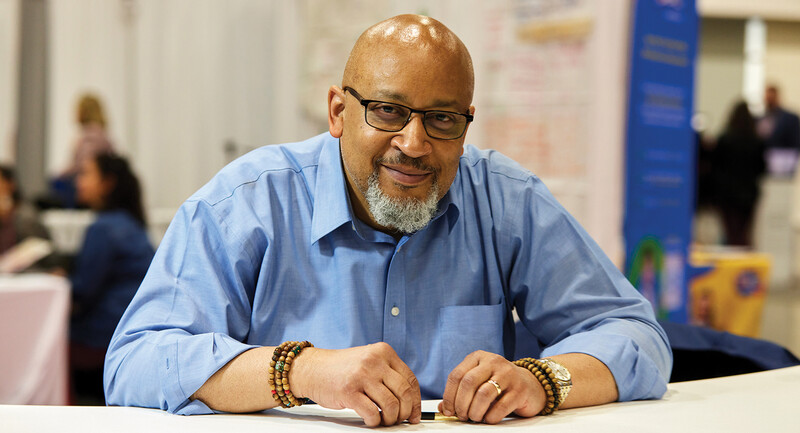Teachers bring varying levels of skill, preparation, and experience to their jobs. And principals, as the instructional leaders of their schools, are tasked with developing teachers' abilities through formal and informal classroom observations and feedback. But how can school districts ensure that principals themselves have the skills they need to fulfill this crucial role?
In 2012, the Clarke County School District in Athens, Georgia, developed a system in which central office administrators help principals build their instructional leadership skills through a strategy called conversation walks. As superintendent of Clarke County at that time (Philip) and the University of Georgia's professor-in-residence for the school district (Sally), we want to describe how conversation walks created learning opportunities for both school leaders and district leaders.
District Challenges and Gains
The Clarke County School District serves about 13,680 students in 21 schools. About 49 percent of the students are black, 24 percent are Hispanic, 21 percent are white, and 2 percent are Asian. More than 82 percent of students receive free or reduced-price lunch, 12 percent are English language learners, and 14 percent are classified as having special needs. In the county, more than 30 percent of children live in poverty, 49 percent live in single-parent homes, and 19 percent of adults who are 25 years or older did not complete high school—all significant risk factors for academic failure.
With a systemwide focus on the use of effective instructional practices across all classrooms, the district has made substantial gains on state assessments in mathematics and language arts. Today, the district's graduation rate is 80.1 percent, above the state average for the second consecutive year—a first since the passage of the No Child Left Behind Act in 2001.
Why Conduct Conversation Walks?
In 2009, the Clarke County School District created a common districtwide instructional focus by implementing the "Non-Negotiable Practices for High Student Performance." In 2013, this document was revised and renamed the "Commitments for High Student Performance." It included observable practices that were required to be implemented in every classroom. These practices were jointly developed by teachers, principals, and central office leaders, and their implementation was supported through formal classroom observations, professional development, and frequent formal and informal classroom walkthroughs.
Although change was underway, district leaders recognized that these traditional implementation steps were not enough. There was still a large gap between the expected instructional practices and those that were actually occurring in classrooms. To fully realize the potential of the instructional reforms, the district needed to ensure that principals were highly skilled in observing and conferencing with teachers to improve their practice. So the district designed conversation walks to meet this need.
How Conversation Walks Work
A conversation walk in the Clarke County School District is a unique one-on-one learning opportunity for both the principal and the central office leader, consisting of classroom observations followed by immediate debriefing conversations about the instructional practices they have observed. The walk may be conducted by the superintendent, an associate superintendent, or one of the executive directors for elementary and secondary instruction. Each conversation walk takes about half a day, and it typically includes observations of four to six classrooms. The school system plans three conversation walks per year with each principal.
First, the central office leader and the principal meet to develop a focus for the conversation walk connected to one of the observable practices established by the district (for example, differentiation); then they observe instruction in a number of classrooms, looking for that practice. The length of each classroom observation varies depending on the time needed to see and hear the selected practice.
The central office leader and the principal debrief after each classroom observation, talking about what they have observed. At the conclusion of the conversation walk, they analyze their observations to identify common threads across all the classrooms and to pinpoint concrete takeaways from the experience. They ask questions like, How did the lessons support the district curriculum and pacing guide? Was each part of the district's required instructional framework evident, appropriate, and effective? What are some instructional variations or suggestions that could strengthen the lessons? Were the strategies executed differently in each class?
These debriefing conversations serve two primary purposes. First, the conversations act as guideposts for principals in understanding the range of instruction in their schools. Second, the conversations help central office leaders assess specific growth goals for principals, monitor progress, frame constructive feedback, and identify future instructional areas in which administrators need coaching.
Although the format is informal and all aspects of the instructional process are open for discussion, the conversations focus on clearly defined teaching practices found in the Clarke County Schools' "Commitments for High Student Performance" and the accompanying observable practices. The conversations use a common vocabulary embedded with understandings of practice as defined by the district. The goals of the conversations are to
- Offer a safe place in which to challenge understandings and examine competing interpretations of what was observed.
- Challenge the status quo so that principals can rethink their practices related to improving instruction.
- Help principals grapple with the meaning of instructional practices that might be new to them.
- Increase individual and collective knowledge and understanding about student learning for both central office and school leaders.
- Support principals who might need to have difficult conversations with teachers.
- Inform principals' professional learning and facilitate ongoing conversations about practice and growth across the school district.
The conversation walk focuses exclusively on principals' professional learning to support and develop their skills in observing and engaging teachers in conversations to improve practice. Although the school district mandates that every teacher who is observed gets feedback using the observable practices, and the conversation walk debrief covers strategies on how to engage in conversations with teachers, principals decide how they will engage teachers in discussing what the administrators observed.
A Sample Conversation Walk
During one conversation walk, the principal wanted to look at the instructional practices related to planning—specifically, the district requirement "to create lessons using the district Instructional Framework that are engaging, rigorous, and aligned to the required curriculum." (For a detailed description of these practices, see Figure 1.) In this conversation walk, the principal and district superintendent decided to visit six 8th grade science classes and to focus their observations on the effectiveness of the lesson plans (which the teaching team had developed collaboratively).
Before the conversation walk, the superintendent and principal reviewed the teachers' daily lesson plans, noting whether these plans included the components of the Clarke County School District Instructional Framework (beginning of lesson, mini-lesson, work session, and closing of lesson). In addition, the superintendent and principal noted whether the instructional standards being taught were aligned to districtwide pacing guides and reflected the right level of challenge for 8th grade.
In the debriefing session immediately following each observation, the principal and superintendent discussed what they saw. For example, one middle school teacher opened the class by reviewing math problems from the homework for 30 minutes. The superintendent asked the principal whether that was an effective "beginning of lesson" according to the district's commitment for planning practices. When the principal quickly responded, "She's one of our better teachers," the superintendent redirected the principal's attention to the expected observable practices (that the beginning of a lesson should establish the expected learning outcomes, communicate an essential question, and so on).
After completing four observations, the principal and superintendent noted a pattern of inconsistency in implementing the expected beginning of lesson practices. As a result of their conversation, the principal determined that he needed to provide more professional development to support these practices; he also planned to be more actively involved in reviewing lesson plans and participating in collaborative planning meetings. From a systemwide point of view, the superintendent noted similar patterns in other schools; this insight guided his subsequent discussions about principal professional development with the instructional services staff.
The superintendent and principal agreed that their observation in the first teacher's classroom indicated the need for a focused conversation between the principal and that particular teacher. Essentially, the principal and superintendent agreed that although reviewing homework serves a purpose, spending 30 minutes on this activity did not activate learning. In addition to the length of this lesson segment, they noted that the lesson lacked a clear learning objective, an organizing element beyond reviewing the answers to questions, a connection to the previous day's lesson, and a transition to the mini-lesson. The superintendent and the principal discussed several opening strategies the teacher could have used to activate student learning. The superintendent modeled an opener and then role-played with the principal how he could coach the teacher on the use of more effective openers.
If You Believe It, Lead It
Even when school and district leaders make instruction a priority, the dynamics of lesson design, development, and implementation are complex. In addition, no two leaders' challenges are the same—principals think differently from one another, and they encounter issues that are specific to their school. Creating the knowledge and confidence to lead instructional improvement takes time, practice, and feedback—all within a relationship of trust and respect. It is imperative that central office leaders create multiple opportunities to coach, supervise, and evaluate principals as they lead the instructional program.
There is no quick-and-easy strategy to make a principal grow into his or her role as instructional leader. But focused conversations can get the principal and central office leaders talking and thinking about how to best provide instructional leadership for teachers. In the Clarke County School District, conversation walks have created a natural method for leaders to gain confidence in their new roles and carry forward this crucial work.









